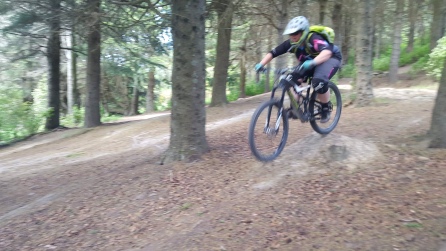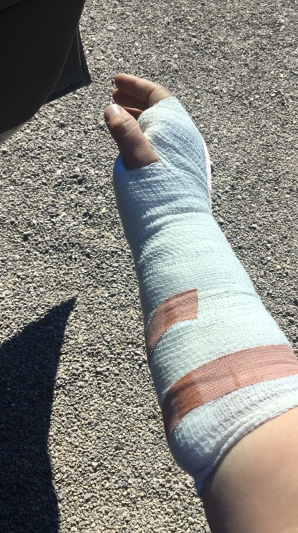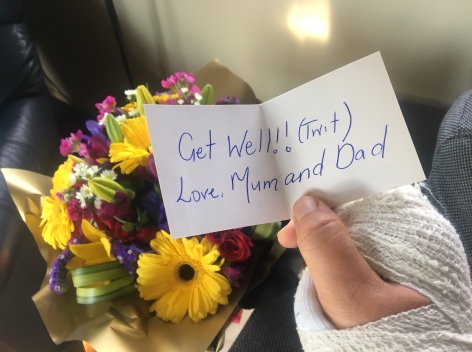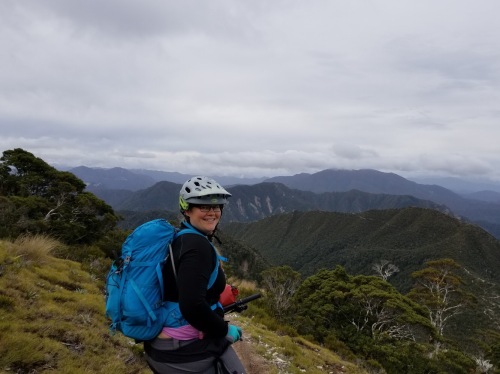One month ago I broke my hand. I’m back to work now, but as I mentioned in my last post I ended up taking disability time off because I wasn’t able to doctor effectively with only one hand.
I’ve mentioned it before on this blog, but my dad is a pretty good sport, so the morning after making the decision that I’d be taking some time off work I gave him a call and said “Come visit!”.
Without hesitation, he did. Within 24 hours he was on a plane and winging his way to Christchurch. We had a fantastic visit, which I have dubbed “The Broken Hand Tour”.
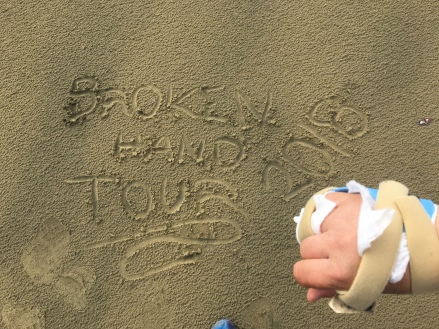
I picked my dad up at the airport early afternoon, and without any break took him directly to the Canterbury Agricultural and Pastoral Show (or “A&P show” as everyone knows it here). I had spent a few hours at the show last year and had loved it, and it was great to share the experience with my dad. It has all the classic “Farm Fair” things”: animals, classic tractors, fair-food, etc. but also some wonderful kiwi-extras. There are pens of ewes that are lambing, sheep-herding competitions, (I believe there are shearing competitions but I’ve missed these both years), and I love the mix of wares for sale in the expo hall where you will find “the most efficient possum trap” for sale in a booth next to children’s bouncy toys. There are rows of fleeces on display, and lots of silver cups for the champion merino fleece. Both years I’ve loved watching some of the wood-chopping competition, and this year got to see the Jiggerboard event, where competitors make notches in a large trunk which they then stand on to make more notches, ultimately placing three steps before chopping half-way through the top of the trunk before repeating the process on the other side and removing the top of the trunk. (You can see the various ax events here)

The Jiggerboard Ax event: It’s impressive to watch these guys in full swing standing precariously on boards resting in notches they just cut.

Prize winning Merino fleece.
This was actually my dad’s third visit to see me in New Zealand, having come over once in the summer to explore and once in the winter to ski. I’d been hoping to get him back for a trip down to Stewart Island (Rakiura), so when he agreed to a last-minute visit I quickly put together plans to do just that. I planned out a southern route, down along the southeast coast, through the Catlins and then over to Stewart Island and then returning through an inland route.

Our loop. Not pictured, the Ferry ride over to Oban on Stewart Island.
We set out the following day (after a visit with my hand therapist) and made our way to Dunedin, the second largest city in the Southern Island. We stopped in Oamaru, the “Steam Punk Capital” of New Zealand, where we visited the Steam Punk Headquarters and had lunch at a brewery. Oamaru is an interesting city, with some beautiful old architecture and an interesting vibe. I’m not sure how much the steam-punk scene has changed Oamaru or how much the steam-punk scene just fit in there, but it’s cool, and definitely worth a visit if you’re in the area. If you visit the actual Steam Punk HQ (on Humber St), make sure you spend time in “The Portal”.
From there we stopped in Moeraki, famous for its boulders on the beach, where I spent last New Year camping in the bush and exploring. While other visitors were busy posing by the boulders we spotted a couple dolphins playing in the surf. We made it to Dunedin in the evening in time for a stroll around the octagon and train station before turning in at the Law Courts Hotel.

Moeraki Boulders. This pic is actually from my New Years trip when the skies were blue…

Classic Dunedin architecture
The next day we headed off (in the rain) into the Catlins, the sparsely populated south east corner of New Zealand. We spent two days visiting sites such as Nugget Point and multiple waterfalls while spotting birds such as the Royal Spoonbill and various gulls, shags (cormorants), and oyster catchers. On the afternoon of the second day we made our way to Invercargill and spent a couple hours in Queen Park before heading to the southernmost town on the South Island, Bluff, from which we caught a ferry to Stewart Island.
Stewart Island is 30km south of the South Island and you can get to it by a catamaran ferry or small airplane. It has one town, Oban, with under 400 fulltime residents. The main industry historically has been fishing, and while fishing and aquaculture are still significant enterprises, the main industry these days is tourism. I’ve wanted to visit Stewart Island partly to see some of the cool New Zealand birds which I hadn’t yet seen. New Zealand is famous for birds, but sadly many are quite limited in number and habitat because of introduced predators and habitat loss. Stewart Island is a good place for seeing birds, and Ulva Island, a smaller island within an inlet on Stewart Island, is a predator-free island where native birds are thriving.

The view from our Airbnb across Paterson Inlet: great for watching storms roll in.
Unfortunately, the weather during out trip wasn’t ideal for really exploring Stewart Island, but we did get out on a guided night tour on the day of our arrival and saw kiwi in the wild. The Southern Brown Kiwi are doing well on Stewart Island (in part due to predator control and programs such as dog kiwi-aversion training). We saw about 5 on our hour-long patrol of the airstrip. They really are funny looking creatures. As my dad said “Proof that God has a sense of humor!”. Or proof that funny things evolve in the absence of predators!
The next morning, we spent hunkered down in our Airbnb watching storms roll over Patterson’s Inlet. When the wind would die down, Tuis would flit around the trees around the balcony and a Kaka, one of New Zealand’s resident Parrots, would stop by. In the afternoon, the weather settled enough for us to have a stroll around town, and we had a wonderful dinner at the Church Hill Restaurant (the Stewart Island Salmon was delicious).
The next day, despite the rain, we set off on a van-tour of the island and learned the history of the island and its inhabitants. In the afternoon, we hopped on the Ulva Island Water Taxi, and after a quick briefing from the captain “It’s going to be very bumpy”, we took the short ride over to Ulva Island. I’d checked out various options online, including self-guided tours and multiple commercial options, and ended up asking Peter from Sail tours to take us round. He’s been on Stewart Island since 1969 and has a wealth of knowledge about the human and the natural history of the area. I was very excited to see a number of Saddlebacks, as well as Red Crowned Parakeets and Brown Creepers- birds I hadn’t yet spotted on Stewart Island. (I like birds, and I’m enjoying learning the New Zealand birds, but by no means am I a “birder”.)
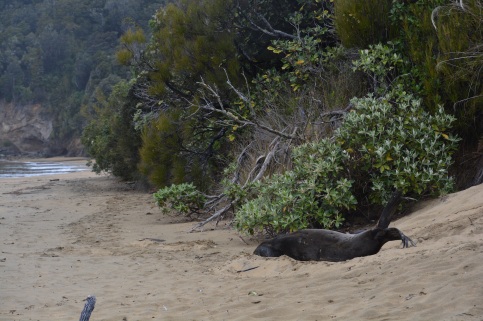
While Ulva Island has been cleared of predators, it’s not just for the birds… It’s good to give Sea Lions a wide berth.
The seas were so rough on our second day on Stewart Island that none of the three scheduled ferries back to Bluff were attempted. We were scheduled on the 8:30am ferry the following day, which thanks to the cancelled ferries the day prior was quite full. We made it across the Foveaux strait safely, though the crew were kept busy helping a number of passengers who weren’t comfortable on the rough crossing. The boat was called Stewart Island Experience – and some passengers had rather more experience than they probably wanted!
To complete our southern route we drove back up through Invercargill and along Lake Wakatipo, skirting around Queenstown, and stopping at the Gibbston Valley Winery before making it to Cromwell where we spent the night. On the last day of our Tiki Tour* we stopped at the High Country Salmon Farm, where they raise King Salmon in freshwater lakes (specifically in hydro canals outside of Twizel). We had a late, yummy sashimi breakfast before heading to Lake Tekapo to see the classic (though now seemly always crowded) views of Aoraki Mt. Cook. We finally completed our loop back to the Christchurch area via the inland scenic route.
In the last 14 months I’ve used most of my free-time in New Zealand to explore the South Island, and I’ve seen quite a lot of it. There are always new things to see and explore, and in New Zealand there seems to be no end to the natural beauty. I always feel lucky when I have someone to enjoy it with!
*A classic kiwi-name for a sight-seeing journey










